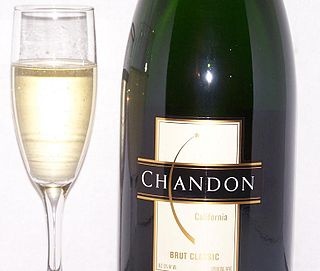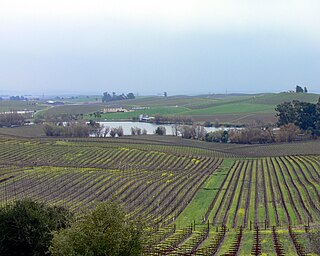
Wine Country is the region of California, in the northern San Francisco Bay Area, known worldwide as a premier wine-growing region. The region is famed for its wineries, its cuisine, Michelin star restaurants, boutique hotels, luxury resorts, historic architecture, and culture. Viticulture and wine-making have been practiced in the region since the Spanish missionaries from Mission San Francisco Solano established the first vineyards in 1812.

Napa Valley is an American Viticultural Area (AVA) located in Napa County, California. It was established by the Bureau of Alcohol, Tobacco and Firearms (ATF) on January 27, 1981. Napa Valley is considered one of the premier wine regions in the world. Records of commercial wine production in the region date back to the nineteenth century, but premium wine production dates back only to the 1960s.

Domaine Chandon is a winery located in the town of Yountville, California, in the Napa Valley. Established in 1973 by Moët et Chandon, and led by businessman John Wright, who operated the company for over 20 years, it was the first French-owned sparkling wine producer in the Napa Valley.

The Augusta AVA was established on June 20, 1980 as the first federally approved American Viticultural Area, eight months before the Napa Valley AVA in northern California. The petition was submitted by Clayton W. Byers and Lucian W. Dressel, representing the local wine industry, to the Director of the Bureau of Alcohol, Tobacco and Firearms on October 16, 1978. Located entirely within the state of Missouri, the boundaries of this wine region encompass 15 square miles (39 km2) around the city of Augusta near the intersection of St. Charles County, Warren County and Franklin County.

Sonoma County wine is wine made in Sonoma County, California, in the United States.

Los Carneros AVA is an American Viticultural Area which includes parts of both Sonoma and Napa counties in California, U.S.A. It is located north of San Pablo Bay. The proximity to the cool fog and breezes from the bay makes the climate in Los Carneros cooler and more moderate than the wine regions farther north in Napa Valley and Sonoma Valley. The cooler climate has made Los Carneros attractive for the cultivation of cooler climate varietals like Pinot noir and Chardonnay. Many of the grapes grown in Los Carneros are used for sparkling wine production. Receiving its AVA status in 1983, the Carneros area was the first wine region in California to be defined by its climate characteristics rather than political boundaries.

The Atlas Peak AVA is an American Viticultural Area located within Napa Valley AVA just northeast of the city of Napa. The appellation sits on a higher elevation than most of Napa's wine region which limits the effects of the cool fog coming in from Pacific Ocean. The westward orientation of most vineyards on the Vaca Mountains also extends the amount of direct sunlight on the grapes. The soil of this AVA is volcanic and very porous which allows it to cool down quickly despite the increased sunlight. The area has a fairly significant diurnal temperature variation upwards of 30 °F (17 °C) between daytime and night. This contributes to the balance of acidity that grapes from Atlas Peak vineyards are known to have.
Mount Veeder AVA is an American Viticultural Area located within Napa Valley AVA among the Mayacamas Mountains. The boundaries of this appellation include 25 sq mi (64.7 km2) with 1,000 acres (400 ha) planted on thin volcanic soil. Many vineyards are found on the steep mountain face some as steep as 30°. The steepness of the angle gives the vineyards benefits of more direct sunlight and better drainage.

The Oakville AVA is an American Viticultural Area located within Napa Valley AVA and centered on the town of Oakville, California. The appellation extends over a flat expanse of well-drained gravel soil between the Vaca and Mayacamas Mountains. Oakville AVA is known for its success with Bordeaux varietals, which have produced wines of rich texture, firm tannins, and notes of mint and herbs.

The Rutherford AVA is an American Viticultural Area located within Napa Valley AVA and centered on the town of Rutherford, California. The area is known for its unique terroir particularly with its Cabernet Sauvignon. The well-drained soil of this area is composition of gravel, loam and sand with volcanic deposits and marine sediments from the Franciscan Assemblage. The appellation accounts for only 6,650 acres (27 km2) in the center of Napa Valley but has been home to some of the regions most historic and world-renowned wineries such as Beaulieu Vineyards, Rutherford Hill, Raymond Vineyards, and Inglenook Winery.

St. Helena is an American Viticultural Area (AVA) located within Napa Valley, centered in and around the town of St. Helena, California. It was established by the Bureau of Alcohol, Tobacco and Firearms (ATF) on October 11, 1995, after the ATF received a petition from Mr. Charles A. Carpy, Chairman of the St. Helena Appellation Committee, proposing to establish a new viticultural area in Napa County to be known as "St. Helena."

The Stags Leap District AVA is an American Viticultural Area located within the Napa Valley AVA 6 miles (9.7 km) north of the city of Napa, California. The Stags Leap District was the first appellation to be designated an AVA based on the unique terroir characteristics of its soil. The soil of this region include loam and clay sediments from the Napa River and volcanic soil deposits left over from erosion of the Vaca Mountains. Like many Napa Valley AVAs, Stags Leap District is particularly known for its Cabernet Sauvignon. In 1976 at the Judgment of Paris wine tasting, the 1973 Stag's Leap Wine Cellars Cabernet from the area that would become this AVA won first place in the red wine category, beating out classified Bordeaux estates. Today, the Stags Leap District is home to twenty different wineries.
The Mendocino AVA is an American Viticultural Area within the larger North Coast AVA. Several small AVAs are nested inside the Mendocino appellation and it roughly encompasses Mendocino County, California. The Mendocino AVA is known for the cultivation of Mediterranean climate grapes including Carignan, Charbono, Grenache, Petite Sirah, Syrah and Zinfandel. Because of its cooler climate, the Anderson Valley is known for its Pinot noir and sparkling wine production. Many wineries in nearby Sonoma and Napa counties purchase Mendocino grapes to blend into wines labeled with other appellations.
The Oak Knoll District of Napa Valley AVA is an American Viticultural Area located within Napa Valley AVA at the southern end of the valley floor. The appellation's close proximity to San Pablo Bay results in a climate that is cooler and more moderate than any region in Napa Valley other than the Los Carneros AVA. The AVA has more vines planted to it than any other wholly contained appellation within the Napa Valley. A wide variety of wine grapes do well in this climate, including varieties not widely grown in other parts of Napa Valley, such as Riesling and Pinot noir. The district is planted largely to Merlot, Chardonnay and Cabernet Sauvignon, in that order. Oak Knoll District Chardonnay has a reputation for a restrained, delicate style. The appellation was officially designated an appellation within the Napa Valley AVA on April 26, 2004.
The Chiles Valley is an American Viticultural Area (AVA) located in Napa County, California and a sub-region within Napa Valley AVA. It was established as California's 81st AVA by the Bureau of Alcohol, Tobacco and Firearms (ATF) on April 19, 1999 after the ATF received the petition from Mr. Volker Eisele, owner of the Volker Eisele Vineyard and Winery proposing a new viticultural area in Napa County to be known as "Chiles Valley District".

The Diamond Mountain District AVA is an American Viticultural Area located in California's Mayacamas Mountains in the northwest portion of the Napa Valley AVA. The appellation sits at a higher elevation than most of Napa Valley's wine region, resulting in less cool fog coming in from San Pablo Bay, and more direct exposure to sunlight. The soil of this AVA is volcanic and very porous which allows it to cool down quickly despite the increased sunlight.

The Howell Mountain AVA is an American Viticultural Area located within Napa Valley AVA of California.
The Wild Horse Valley AVA is an American Viticultural Area whose borders overlap both Napa County and Solano County, California and is partially contained within the Napa Valley AVA. The appellation's southerly location results in more hours of sunshine than other locations in Napa Valley or nearby Green Valley. The proximity to San Pablo Bay results in a cooler climate, making Wild Horse Valley attractive for the cultivation of grapes like Pinot noir.

The Spring Mountain District AVA is an American Viticultural Area located in the Napa Valley AVA in California. Spring Mountain District AVA was officially established as an American Viticulture Area in 1993. Encompassed within its bounds are about 8,600 acres (3,480 ha), of which about 1,000 acres (400 ha) are planted to vineyards. Given the small crop yields on hillsides, the region represents less than 2% of Napa Valley wine. Currently the region has just over 30 winegrowers.

The Calistoga AVA is an American Viticultural Area located in the northern portion of California's Napa Valley AVA. The appellation is distinguished by its volcanic soil, high temperatures up to 100 °F (38 °C) during the day, and cool nights during the growing season due to breezes from the Russian River, causing the highest diurnal temperature variation in the Napa Valley—up to 50 °F (28 °C).















